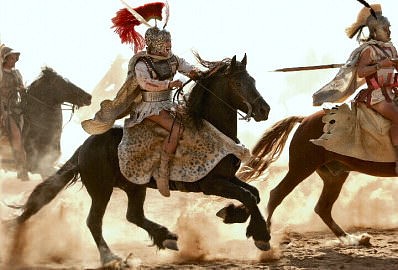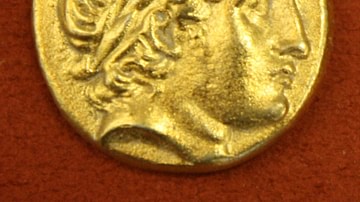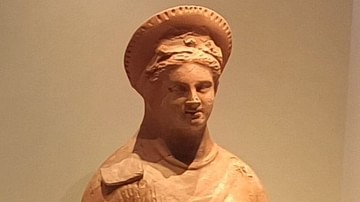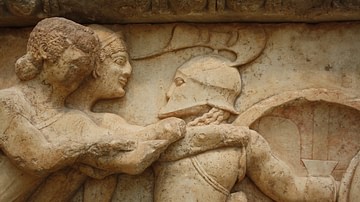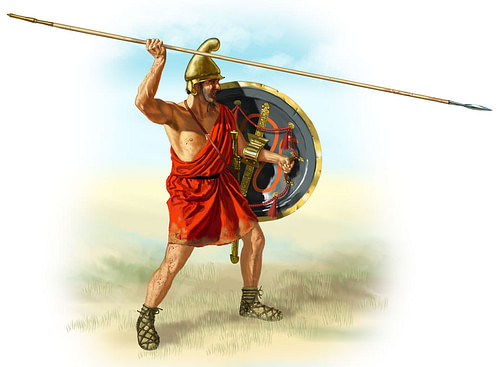
The hypaspists or hypaspistai were a distinct type of infantry soldier who served as a vital part of the Macedonian armies of both Phillip II of Macedon (r. 359 BCE - 336 BCE) and his son and heir Alexander the Great (r. 336-323 BCE). The hypaspists became an invaluable part of the infantry that helped expand the Macedonian Empire.
Hypaspists were part of the Macedonian armies which conquered Greece and defeated both the Persian forces of Darius III (r. 336-330 BCE) and the Indian army of King Porus, aiding in the establishment of an empire that stretched from the Peloponnesian peninsula northward through Macedon and Thrace, across the Hellespont into Asia Minor and southward into Syria, Mesopotamia, and Egypt. Although their exact origin and function have been called into question, their abilities have not. The historian Stephen English in his The Army of Alexander the Great refers to them as being “among the most capable and heavily worked troops in the Macedonian order of battle …” (28)
Debate on Role & Weaponry
While they are credited for their valiant role in the conquest of Asia, many modern historians are unsure of the evolution and exact role of the hypaspists; even their equipment and attire are in question. This confusion was evident in the writings of many early historians who could not agree on something as simple as whether or not they carried the eighteen-foot sarissa (a type of long spear or pike) of the phalanx hoplites (see below), a short double-edged sword (the xiphos), or a javelin. Most agree, however, that they were unique, hand-picked not only for their speed and endurance but also for their strength and courage.
Unlike their fellow phalangites, they were not recruited from the social elite but from the same class as the pezhetairoi: the peasantry. Unlike the pezhetairoi, however, they were not chosen along tribal lines. Some historians maintain they served as a select but separate unit of the phalanx. Most agree that they formed a direct link between the heavy infantry of the center, stationed to the right of the Companion Cavalry next to Alexander (a place of honor). This was seen at both the Battle of Issus and the Battle of Gaugamela. Others suggest that they may have served on particular occasions or during special events as part of a guard, an agema — a strike force not designed for a prolonged frontal assault. Their mobility, far better than that of the pezhetairoi, allowed them to fight on rough terrain, in siege warfare, and in close hand-to-hand combat; in fact, anywhere where the sarissa of the pezhetairoi was useless.

Origins: Protecting the Phalanx
Another area of contention is the origin of the hypaspists. Most agree that they evolved from the pezhetairoi of Philip II. Inheriting an army that was disorganized and ineffective, Philip totally transformed the Macedonian army when he became king. The retooled infantry marched in a close-ordered formation or phalanx where each soldier carried his shield in a manner that protected his left side and his neighbor's right. This new style of fighting was primarily offensive, advancing in a line into the center of the opposing enemy. But Phillip had noticed a weakness: the vulnerability of a flank attack. The solution was the creation of the hypaspists who were equipped with a larger shield and spear, making them more flexible and able to protect the phalanx. Both Phillip and his son Alexander believed in training and discipline, and the hypaspists received far more than anyone else; Stephen English claims that more was expected for a member of the king’s bodyguard.
New Look & Training
However, before anyone could be trained, the typical Macedonian soldier was given a new look. For protection, he wore a Phrygian helmet which allowed for better hearing and visibility. He wore greaves to cover his calves, a molded cuirass that shielded his torso as well as a long, pleated tunic that protected his abdomen and groin. However, evidence indicates that the hypaspist differed by wearing a linen corselet and pteruges (hanging straps) to protect his groin and upper thigh. This would allow for flexibility to mount a horse if necessary — evident in their pursuit of Darius after Gaugamela. Again, the hypaspists may or may not have been dressed in this manner. It was all a question of mobility. The hypaspists could have needed a uniform that allowed for better movement. And, concerning his choice of weapons, the sarissa would have been far too cumbersome, a much shorter sword was a better choice.
Together with the rigorous training, these new uniforms gave each man a sense of unity and solidarity; he would no longer be loyal to a particular province or town but loyal only to the king, even declaring an oath of allegiance. Whatever their appearance, Philip took a poorly disciplined group of men and turned them into a formidable army — bringing much of Greece under his influence. After his father's death, Alexander would fulfill Philip's dream and take this remarkable force into Asia and battle the Persians with success.
An Offensive Army
Among the forces that crossed the Hellespont with Alexander in 334 BCE were 3,000 hypaspists: three units (chiliarchies) of 1,000 each. They would remain by Alexander’s side at Granicus, Issus, Gaugamela, and against King Porus in India. Each chiliarchy was under the command of a chiliarch or pentakosiarch — likely chiliarchs included Admetus, Hephaestion, and Seleucus. Each chiliarch was selected on the basis of valor. Initially, they served under the overall command (archibypaspistes) of Nicanor, son of Parmenion, from 334 to 330 BCE and later under Neoptolemus. These commanders were Macedonian nobles appointed by the king. According to English, Alexander’s army was created and designed for attack, that is, to be an offensive weapon with the mission to destroy the enemy as quickly as possible. He had no interest in conducting a defensive operation, and the hypaspists proved to be an integral part of this strategy throughout his campaign in Thrace and into Asia Minor. English noted that there were three elements to the Macedonian infantry: the asthetairoi (a well-trained infantry from Upper Macedonia), the foot-companions or pezhetairoi, and the hypaspists.
There were three types of hypaspists:
- The royal hypaspists or basilikoi were from an aristocratic background and initially under the command of Hephaestion and later Seleucus, functioning as a bodyguard to the king (some had been royal pages).
- The regular hypaspists.
- The argyraspides who came into existence in 327 BCE and were composed mostly of veterans. The argyraspides would eventually become the “silver shields” and fought during the Wars of the Successors. In 318 BCE, they joined Eumenes in his battle against Antigonus I, the One-eyed. Eventually, they surrendered to him in exchange for their wives and baggage.
Alexander in Command
After the death of Phillip in 336 BCE, Alexander had to prove himself as a capable and formidable commander, not only to the people of Greece but also to his own men. Before he crossed the Hellespont, he had earned both. Alexander used cunning and deception when facing an enemy. “He was not the kind of commander who would simply charge blindly into battle. His encounters were thought out and if he could trick the enemy into a mistake he was more than willing to do so.” (Field Campaigns, 64). One of the initial targets of his Balkan campaign was the Thracians and their defense of the Shipka Pass. Using wagons as a defensive palisade, they had plans to send them crashing down on the advancing Macedonians. Alexander understood their intentions and ordered his hypaspists to break formation and press tightly against the walls of the pass, allowing the wagons to pass by; there were no casualties. This tactic would later be used against Darius’ scythed chariots at Gaugamela. Using both the Agrianians and hypaspists. Alexander staged a final assault; 1500 Thracians were killed.
In Action: Issus & Gaugamela
After Alexander recovered from a serious illness, the Macedonians would encounter Darius at Issus on 5 November 333 BCE. The two armies met at the River Penarus. The area did, however, provide a distinct advantage for Alexander because not only did it reduce Darius's mobility but he could also spread out his own troops. The entire battle did not go well for Darius. He and his men were soon on the defensive, unable to maneuver as they would have liked. Darius's left flank was hampered by the river valley, mountains on his left, and the sea on his right. The hypaspists and pezhetairoi attacked the Persian center while Alexander and his cavalry attacked on the right, allowing for a gap in the Macedonian line. Once across the river, the pezhetairoi attacked the Greek mercenaries while the hypaspists advanced towards Darius and his bodyguards. With the combined attack on the center and far right, the Persians retreated. In his Masters of Command, Barry Strauss wrote that Alexander “displayed agility as well as insight above all, it was an exercise in audacity.’ (15)
At Gaugamela on 1 October 331 BCE, as with other battles, at the center was the Companion Cavalry, then came the heavy infantry on the right led by the hypaspists under the command of Nicanor. As the battle began, Alexander and his Companions immediately moved to the right at an oblique angle. Following Darius's orders, the Persians moved to their left, countering Alexander in an attempt to outflank him. As the Persians moved further to their left, a gap was created. This entire move by Alexander had been a feint. Seeing the opening, Alexander formed his men into a wedge and quickly moved to his left and into the clearing, charging the shocked Darius with a Macedonian war cry. Among those charging were the hypaspists and pezhetairoi. English writes that the great failing of the Persians was allowing the gap to develop between the left and center. The Persians did not have enough infantry to maintain a “cohesive link.” “This is a role that would have been played by the hypaspists of Alexander.” (147)
Conclusion
Ancient and modern historians, disagree on many facets of the hypaspists. What makes it even more difficult is their language. For example, while 'hypaspists' is often used, the term doryphoroi also appears in some histories. The historian Arrian in his The Campaigns of Alexander makes mention of the hypaspists not by name but by position, referring to them as ''the Guards. Against the Scythians, while his siege engines addressed the walls, Alexander “ordered the Guards, the archers, the Agrianes and his personal guard to hold themselves in readiness.” (204) Similarly, there are conflicting interpretations of their origin. There is even disagreement on their equipment - sarissa or javelin. And, lastly, there is inconsistent information on their role: were they considered light or heavy troops? Oddly enough, putting aside whatever may cause contention; most historians agree that the hypaspists were an integral part of the army of Alexander - an army that crushed the Persian forces of Darius III. There is little dispute on the basics: they were well-trained and disciplined, stationed between the heavy infantry of the phalanx and the Companion Cavalry, and they fought on rough terrain and in hand-to-hand combat. Whether or not historians agree, the hypaspist was a unique soldier, specially trained and invaluable to their king.


